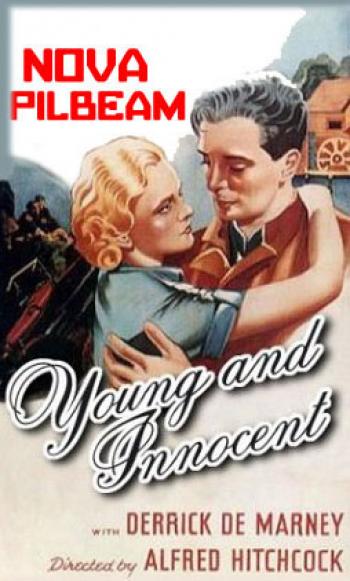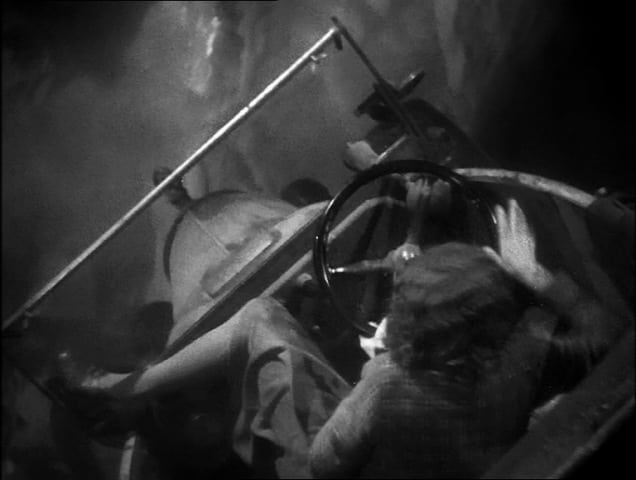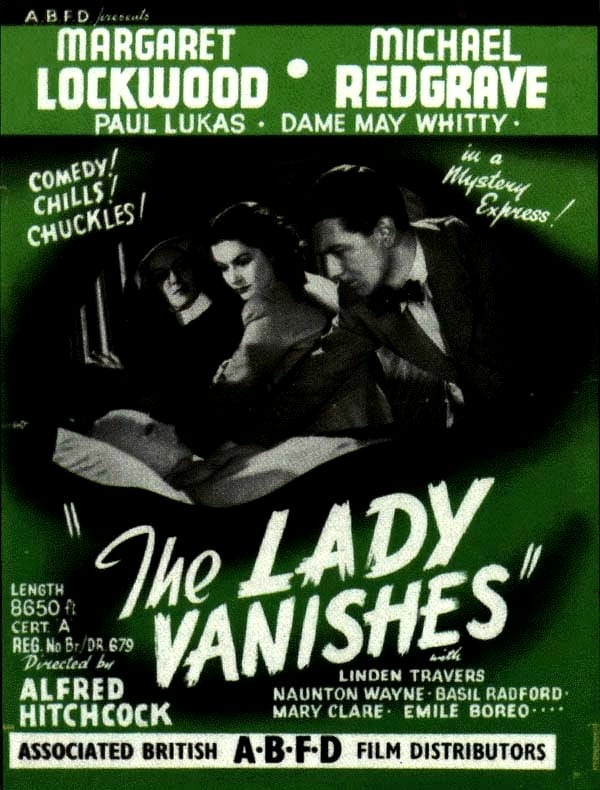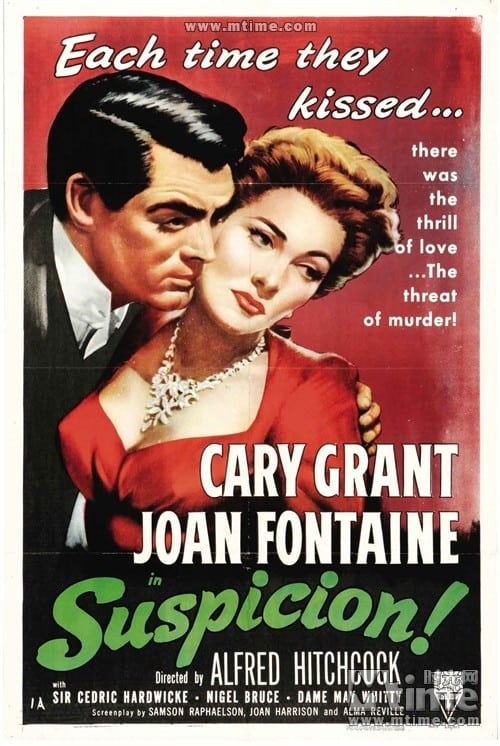Young And Innocent (1937)
Directed by: Alfred Hitchcock
Written by: Anthony Armstrong, Charles Bennett, Edwin Greenwood, Gerald Savory, Josephine Tey
Starring: Derrick De Marnay, Edward Rigby, Nova Pilbeam, Percy Marmont
UK
AVAILABLE ON DVD
RUNNING TIME: 77 min
THE HITCHCOCK CAMEO: Posing as a photographer and holding a camera outside the public entrance to the courthouse just after Robert Tinsdall has managed to escape.
REVIEWED BY: Dr Lenera, Official HCF Critic
Christine Clay, a successful actress, receives a surprise visit from her ex-husband Guy. They have a row over her many boyfriends, ending with her slapping him several times across the face, and him leaving. The next morning, Robert Tisdall, whom Christine claimed was one of her boyfriends, is walking along the seaside cliffs when Christine’s body washes ashore. He runs to get help and call the police, but is seen racing away from the corpse. A belt from his raincoat is found next to the body, and after he is arrested, the discovery that Christine left him a large sum of money in her will, further implicates him. He takes advantage of a crowded courthouse and makes his escape to track down the real killer….
Young And Innocent plays for much of the time like a more laid-back, simpler The 39 Steps, Hitchcock clearly relaxing after the intensity and emotional complexity of Sabotage. No espionage or politics here: a man is accused of a murder and sets out to clear his name, aided by the daughter of the local police chief, and that’s it. Despite containing some tense sequences, the film overall lacks oomph, its rural settings helping in creating a very laid-back vibe. The result is a film that doesn’t much stick in the memory [I’d seen it two or three times before viewing it for this review, and could only remember a few bits and pieces], but remains a most pleasant, relaxing watch, full of charm and hard to dislike. The plot doesn’t hold much scrutiny if you think about it too much, but you could also say that about masterpieces like The Lady Vanishes and Vertigo. The director is just kicking back and chilling out with this film, and just wants you to do the same. Perhaps it is marking time, but there’s nothing overly wrong with that when the result is so pleasing.
It was supposedly based on a novel by Josephine Tey entitled A Shilling For Candles, but the script by, as usual, Charles Bennett, plus three other collaborators, only really made use of the first two chapters, which focused on a man being accused of a murder and going on the run. The rest of the plot and characters were thrown out, and even the murderer was different. The book was a complex ‘whodunit’, but the film makes it obvious who the killer is right from the beginning; it’s just a matter of finding him. Halfway through shooting, Gaumont-British closed down its film making arm to focus solely on distribution. Hitchcock was in no danger of losing his job, his contract being taken over by Gainsborough, and the production relocated to Pinewood, where he wasted no time in taking advantage of the much greater space available, but his producers Michael Balcon and Ivor Mongatu were fired. The film didn’t use any major stars this time but did employ many familiar faces from previous Hitchcock movies. It was a commercial success, though it had ten minutes removed from the US release called The Girl Was Young, losing a thematically important if plot-wise unnecessary sequence at a children’s birthday party. It was also around this time that Hitchcock began to be courted by American producer David O’ Selznick.
The opening is gloriously melodramatic [and almost at odds with the rest of the film] as we witness a screaming row between two people during a raging thunderstorm. The rest of the film is bright, sunny, even optimistic. It’s perhaps a slight flaw that Robert Tisdall doesn’t seem to be frightened of being caught by the police once he escapes the courtroom he is about to be tried in, in fact he doesn’t show much emotion throughout, though that seems to be chiefly because of the performance of Derrick De Marney, who speaks in a whiny fashion and almost seems to be taking the mickey. The first half of the film concentrates on getting him and the local police chief’s daughter Erika Burgoyne together, she of course being unsure at first, though there’s hardly any of the sexual tension of The 39 Steps here. The second half involves the tracking down of the murderer, in particular the recovering of Robert’s raincoat. The plotting here doesn’t make sense [why would the killer follow Guy to a cafe, steal his coat, remove the belt, then give the coat to a tramp?], but we get to enjoy a fine comic performance by Edward Rigby as the tramp Old Bill who ends up helping them, his attempt at dancing with Erika being especially amusing.
Even towards the end, the story doesn’t gather much momentum until we see the killer, but there are great little bits of business dotted throughout. The children’s party, where hero and heroine are trapped, cops are outside and Erika’s aunt is starting to suspect, is a great example of quiet suspense with added subtext, especially when they play blind man’s buff in a film where impaired vision seems to be a major theme, what with Robert stealing solicitors glasses, the killer having a serious twitch, and other examples. A scene in a mine shaft where the floor of the cave collapses, causing the car to fall below and very nearly losing Erika too until Robert pulls her to safety, is remarkably convincing and almost makes one forgive the poor back projection elsewhere in the film, usually when people are driving in cars. Hitchcock often employed this device because he had greater control of a scene if it was shot in a studio rather than on location. DVD picture quality makes certain visual flaws in old movies very obvious, probably more so than in the original cinema releases, and it’s certainly the case with Hitchcock’s back projection. The same can be said for the model cars in the film, but not many films of the time would have used tiny human figurines that actually move, so one can still be impressed. And you have a truly amazing one minute-ten second crane shot where the camera soars over the lobby and dance floor of the Grand Hotel until locating the killer drumming in the band and eventually his blinking eyes, all to a song called The Drummer Man. Most directors of the time would have waited until somebody in the film recognised the killer before we see him, but Hitchcock, typically choosing suspense over surprise, lets us see him first.
The climax is a little rushed but actually makes us feel a little sorry for the killer. Of course having the device of him being recognisable by a twitch would probably be deemed politically incorrect these days, and the same goes for the black-face musicians which are sickening even when, like me, you’re prepared to usually forgive what may seem offensive nowadays in the context of what was acceptable in the past. What seems quite fresh and modern about Young And Innocent is the often sparking dialogue and slightly mocking edge, including some jabs at the [as usual for Hitchcock, hilariously incompetent] police. “Can’t you give us a bit more room?” asks one of two cops hitching a ride on a farmer’s pig cart, to which the farmer replies, “Cart don’t reckon to hold more than ten pigs”. Other nice comic touches include the solicitor who keeps losing his glasses near the beginning, the talk of children rather than adults replacing the usual scenes of people discussing in blackly comic terms the news, and the spiky relationship between Erika and her cop friends and father. The film is more about her journey rather than Robert’s, her view on life having been shaped by growing up around the police and now drastically shaken up and changed by events.
Nova Pilbeam, the kidnapped girl from The Man Who Knew Too Much who has grown a huge amount in four years, is charming and spunky as a very independent, forthright heroine, her lack of traditional movie star looks making her character seem quite real. Her and and De Marney, who is nearly twice Pilbeam’s age, lack much chemistry though. Elsewhere Percy Marmont from Secret Agent and John Longden [yet again a detective] from Blackmail make strong appearances. Louis Levy’s music is comprised of longer pieces than usual, with a very dramatic one for the opening sequence and some lovely romantic music for the love scenes which is given a dance arrangement in the climax [though it’s noticeable that the drummer in the piece before is not at all drumming in time!]. Overall Young And Innocent, which looks forward to The Trouble With Harry in its feel and setting and even to The Birds with certain elements, is minor Hitchcock, but even minor Hitchcock is usually great fun and full of interest. You’re never be really in doubt that everything’s going to turn out alright, you won’t be on the edge of your seat, and you certainly won’t be disturbed by things like moral ambiguity and the dark side of human nature, but you’ll have a smile on your face for most of the time while you watch this.
Rating: 

















Be the first to comment